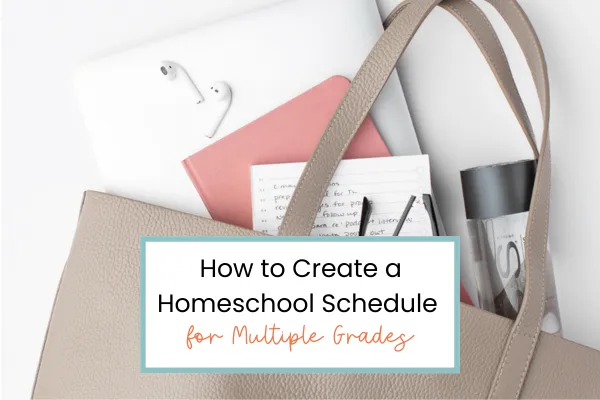

ALL THE LATEST

How to Create a Homeschool Schedule for Multiple Grades
It's never too early to start planning for the coming school year! Next thing you know, we're back into the swing of things! (If you're a traditional school year planner.) So when it comes to planning the schedule for school, it can be a daunting task.
Not everyone has just one child they're teaching so juggling multiple children's schedules in different grades can also feel quite overwhelming.
Each child has their own way of learning, their own needs, and their own attention spans. And sometimes you're just glad you made it through the day, right?

Believe me, I know all about just being glad that we got through the day. However, wouldn't it be so much better if there was a plan to get the schedule working for you? Where you can feel like you're actually ahead of the game, so to speak?
In this blog post, I'm going to talk about both traditional and year-round homeschooling schedules with each of these types of schedules will be slightly different than the other. I'm also including the benefits and challenges of each.
Plus, I'm going to talk about how they differ for younger and older children, and also provide sample schedules for each age group.

Here's the thing to remember: creating a homeschool schedule for multiple grades involves strategic planning and adaptability. That's the beauty of homeschooling!
It offers the flexibility to tailor your child's education to their pace and interests, but it also demands structure to make sure that your educational goals are met.
Let's dive in to the two major scheduling approaches.
Traditional Homeschool Schedule
A traditional homeschool schedule follows the conventional academic calendar, typically starting in late August or early September and ending in late May or early June.
This schedule includes breaks for holidays, a long summer vacation, and aligns closely with the public school system, making it easier to coordinate with extracurricular activities and community programs.
Benefits
Consistency: Mirrors the public school calendar, making it easier to join local activities.
Breaks: Regular holidays and summer vacation provide ample downtime.
Challenges
Pacing: Some children may struggle with the long break during summer.
Pressure: Condensed learning periods can feel intense.
Sample Schedule for Younger Children (Grades K-3)

Sample Schedule for Older Children (Grades 4-8)

Year-Round Homeschool Schedule
A year-round homeschool schedule distributes learning throughout the year, with shorter, more frequent breaks. This approach prevents burnout and allows for continuous learning without long gaps of breaks.
Benefits
Continuous Learning: Reduces learning loss during the longer breaks.
Flexibility: More frequent breaks can prevent burnout.
Pacing: Easier to accommodate different learning speeds.
Challenges
Coordination: May not align with community activities or traditional school programs.
Scheduling: Requires more careful planning to balance breaks and learning periods.
Sample Schedule for Younger Children (Grades K-3)

Sample Schedule for Older Children (Grades 4-8)

Differences Between Younger and Older Children’s Schedules
Younger Children
Shorter Attention Spans: Younger children benefit from shorter, varied activities.
Hands-On Learning: More time allocated to interactive and play-based learning.
Frequent Breaks: Shorter periods of structured learning with regular breaks.
Older Children
Longer Focus Periods: Older children can handle longer blocks of focused study.
Independent Work: More emphasis on independent reading and project-based learning.
Specialized Subjects: Time allocated for electives and deeper dives into subjects.
Designing a homeschool schedule for multiple grades requires balancing the educational needs and learning styles of each child. Whether you choose a traditional or year-round schedule, the key is to remain flexible and adjust the plan as needed.
Younger children thrive with shorter, varied activities and frequent breaks, while older children benefit from longer periods of focused study and independent work. By creating a thoughtful schedule, you can provide a structured yet adaptable learning environment that caters to the unique needs of each child.
Homeschooling multiple grades is a challenging, but highly rewarding endeavor. With careful planning and a flexible approach, you can create a harmonious and effective homeschool schedule that supports the educational growth of all your children.





